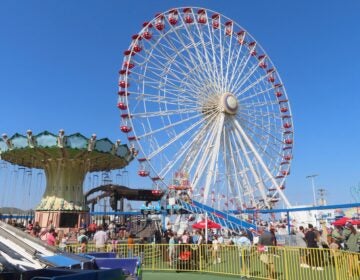Trenton City Museum tracks ceramic evolution
From the 19th to the early 20th century, Trenton was one of two major pottery centers in the U.S. (the other being in East Liverpool, Ohio). Its products were shipped all over the country and at its zenith, in the 1920s, Trenton had more than 50 potteries. Everything from teacups and tiles to toilets were made here. Indeed in was in Trenton where the flush mechanism for the toilet was refined.
And while the first bathtub to be installed in the White House was made in Trenton, the capital city also pioneered the development of art porcelain through the introduction in 1882 of “Belleek” china, using techniques developed in Ireland. Among the well-known Trenton potteries were Lenox, Fulper & Stangl, and Boehm. President Nixon gave Boehm “Mute Swan” figures to the Republic of China when he normalized relations. These products and their history are documented in permanent displays on the second-floor galleries at Ellarslie.
Through April 30, however, Breath of Fire, an exhibit of works by 12 contemporary ceramic artists in the Greater Trenton Region—including mythic faces, expressive torsos, flasks and urns, a one-of-a-kind chess set and abstract kimono sculpture—shows how the medium has evolved. Two important influences on these artists, though not in the exhibition, were New Jersey artist Toshiko Takaezu (1922-2011), who pioneered the closed vessel, and Peter Voulkos (1925-2002), credited with bringing ceramics from a utilitarian craft to a fine art. “The clay is alive and even when it is dry, it is still breathing,” Takaezu once said.
“There has only been individual expression in ceramics in the last 60 or so years,” says curator and artist Susan Hogan. “These individual voices represent a total shift from mass market ware. For these artists, it doesn’t matter what the world wants—they produce from their own intuition and heart.”
Voulkos, a leader of the “Revolution in Clay” (circa 1940-1960), collaborated with Peter Callas, once his studio assistant, who introduced him to using wood-fired kilns, and much of Voulkos’s work after 1979 was fired from Callas’s kiln in Belvidere, N.J.
Callas, one of the featured artists in Breath of Fire, is an abstract expressionist who seeks to “communicate the mysterious sensibilities of nature on fire. My life, together with my art, has been a work in progress. I have lived by intuitive chance, liberating the bad efforts and giving artistic potential a second chance.” When Callas studied pottery in Japan, he learned traditional firing in the anagama kiln, and built the first anagama kiln in the United States in 1976, hosting firings and workshops for the clayworker community in Belvidere. Callas is considered to be one of America’s foremost authorities on the wood fired anagama kiln tradition.
Callas makes vessels, though these vessels are not necessarily functional. Rather, they are more about the clay, and allowing the clay to speak. They are rough and textured, often beaten and battered, sometimes like molten lava.
In his Princeton studio, Thaddeus Erdahl constructs large-scale heads and figures—these inevitably elicit out-loud laughter from viewers. Take his “Private Dazzle.” This head is simultaneously lifelike—that face is definitely someone you know, with eyes that have been up late and a serious expression—and surreal, in that it is larger than life and glazed in stars and stripes of blue, black and green. One ear is perforated like mesh. Look at him from the other side and the serious expression becomes a sly grin.
Before Thaddeus Erdahl became an artist, he served in the military and the experience changed his life. “We were trained to be elite soldiers but were treated like kids,” Erdahl says, explaining the half-size soldier-like figures he creates. “At 20 years old we could blow things up and shoot someone, but we had to ask permission to use the bathroom.”
Erdahl can convey the human condition in the peeling crackle finish on a ceramic head. Pockmarks and drips in the glaze are remains of the suffering a character has endured.
James Jansma also has pockmarks and drips in the texture of the pieces he makes in his Hopewell studio. Influenced by the Zen of Japanese ceramics and a connection to nature, his vessels are a variation of the Asian tea bowl, made large. Jansma’s hand-built vessels provide him with a “canvas” on which to react in a painterly way. “I like playing with rough textures,” he says. The earthscape vases are built up using wet and dry clay, a variety of glazes and repeated firings. “When you put on glaze, it bears little relationship to the color you’ll get when it comes out of the kiln. So it’s a leap of faith. I may fire five to seven times to get the results I want.”
He may take slip (watery clay) and dried chunks of clay from the floor to texture the pieces. “As clay transforms from wet to dry, I’m working with clay in all its states at once,” he says. He likes breaking the rules to get cracks and fissures, all the while making sure the piece is still functional. “I am interested in the process of breaking down and decay.”
Roseanne Ebner works in latticework strips, represented here with “Abandoned,” what looks like an wooden house with a bird in a window and cedar shake shingle roof, all made from clay, as well as “No Longer Holding Water,” a torso with a water tower atop the neck and made from those same slats of clay. She, like Callas, fires in an anagama kiln.
Pam Lethbridge and Scott Rosenthal collaborated on a whimsical series of sculptures. “Geri-Man” has an orange beak with a patterned finish and black and white striped party hat. He’s in a chair on wheels and has two legs, no hands or feet. “Lost in Space” is a figure in a casket, or a mummy case, with cat ears, on a platform with wheels. Look on the reverse side to see a face peering through.
A wall of Lethbridge’s dolls combines ceramic with fiber art in cute macabre figures: one with rabbit ears, another with a ram’s horns, and one that looks like it’s wearing diapers. Punctuating the faces are hollowed-out eyes and screams of horror. Lethbridge worked in the mental health field for 23 years.
Influenced through her travels to Japan, Lisa Cecere has several sculptural works inspired by the kimono. Her “Golden Kol, Kimono Dreams” is a polymorphous shape that evokes some of the traditional pottery upstairs in its glaze: delicate blue and white floral motifs.
Karen Copensky’s small works—a wart hog, a gazelle, an alligator— look, at first, like decorative objects your great aunt may have displayed on the coffee table, but they are intriguing and whimsical and also serve as oil vessels.
There are also works by Laura Demme, Vicky Smith, Ingrid Jordan, Fran Leyenberger and Michael Welliver.
____________________________________________
The Artful Blogger is written by Ilene Dube and offers a look inside the art world of the greater Princeton area. Ilene Dube is an award-winning arts writer and editor, as well as an artist, curator and activist for the arts.
WHYY is your source for fact-based, in-depth journalism and information. As a nonprofit organization, we rely on financial support from readers like you. Please give today.








